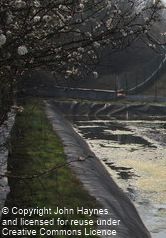 Landfill leachate composition for United Kingdom Landfills was first published in the Waste Management Papers published by the UK Department of Environment. Waste Management Paper 26 contains the most recent table of Landfill Leachate Composition before the WMP series was superseded by later documents, notably the DoE’s Leachate Report of 1995. However, the original table, as published below remains a good guide to leachate quality from the mixture of UK landfills which in those days would have included a mixture of fully lined landfills and lined and progressively capped landfills as often referred to nowadays as Sanitary Landfills.
Landfill leachate composition for United Kingdom Landfills was first published in the Waste Management Papers published by the UK Department of Environment. Waste Management Paper 26 contains the most recent table of Landfill Leachate Composition before the WMP series was superseded by later documents, notably the DoE’s Leachate Report of 1995. However, the original table, as published below remains a good guide to leachate quality from the mixture of UK landfills which in those days would have included a mixture of fully lined landfills and lined and progressively capped landfills as often referred to nowadays as Sanitary Landfills.
Typical [Landfill Leachate] Composition of Leachate from Domestic Wastes at Various Stages of Decomposition (all results in mg/l except pH-value)
| Determinand | Leachate A | Leachate B | Leachate C | |
| (recent wastes) | (aged wastes) | (bioreactive wastes) | ||
| pH-value |
6.2 |
7.5 |
8.0 |
|
| COD |
23 800 |
1 160 |
1 500 |
|
| BOD5 |
11 900 |
260 |
500 |
|
| TOC |
8 000 |
465 |
450 |
|
| Fatty Acids | (as C) |
5 688 |
5 |
12 |
| Ammoniacal-N |
790 |
370 |
1 000 |
|
| Oxidises -N |
3 |
1 |
1.0 |
|
| o-phosphate |
0.73 |
1.4 |
1.0 |
|
| Chloride |
1 315 |
2 080 |
1 390 |
|
| Sodium | (Na) |
960 |
1 300 |
1 900 |
| Magnesium | (Mg) |
252 |
185 |
186 |
| Potassium | (Kg) |
780 |
590 |
570 |
| Calcium | (Ca) |
1 820 |
250 |
158 |
| Managanese | (Mn) |
27 |
2.1 |
0.05 |
| Iron | (Fe) |
540 |
23 |
2.0 |
| Nickel | (Ni) |
0.6 |
0.1 |
0.2 |
| Copper | (Cu) |
0.12 |
0.03 |
– |
| Zinc | (Zn) |
21.5 |
0.4 |
0.5 |
| Lead | (Pb) |
0.40 |
0.14 |
– |
Explanation of the leachate categories shown above:
A) Recently emplaced domestic wastes, in the active “acid-forming” stage of anaerobic decomposition, with rapid production of readily degradable organic materials such as fatty acids.
B) Relatively aged wastes in latter stages of stabilization, containing a lower proportion of biodegradable organic materials (as indicated by the low ratio of BOD: COD), but with continuing biological activity as shown by the concentration of ammoniacal nitrogen.
C) Leachate from rapidly degrading domestic wastes, with active generation of methane, in water saturated conditions. Low concentrations of volatile fatty acids indicate efficient conversion of these to landfill gases, and very high concentrations of ammoniacal nitrogen show a high rate of anaerobic biological activity with the landfill.
Ref: DoE Waste Management Paper No 26
Do you need expert advice on leachate composition and what it means for your landfill? If so, send us the details by completing the form on our Quotations Page, or on our Contact Page and describe your leachate problem, and we will respond to you.



HI
I work at Sari – IRAN municipality as a urban service expert.
In landfill, we have some leachate with COD = 70000 mg/lit.
We are going to treat it by MBR.
Why is there huge variation in the leachate composition? Analysis of data taken, for example comparing hardness, alkalinity, does not satisfy the mass balance?
In a general sense, the reason that the composition of leachate varies so much over time at any particular landfill site, is the change which takes place when leachate decomposes from the acetogenic to the methanogenic phase, to accompany the changes which take place inside the landfill itself. To be more specific I cannot say, unless you would like to share the leachate analysis data to which you refer?
Hello there ,
I am wondering if there has been studies done on concentration of aluminum in landfill leachate? I am concern that aluminum from automobile shredded residue could react with the moist environment of landfill creating heat within landfill and killing off methanogenic bacteria and possibly causing elevated temperature within the landfill …
To be present in leachate it would be in the form of an aluminium salt, but although I am not a chemist I don’t think aluminium is very water-soluble. I say that because surely the big virtue of aluminium which means that the metal does not really “rust or flake” away nearly as quickly as for example iron, is that the surface oxidises but does not get washed away very easily. In any event, aluminium is a very common element in the environment as it is in clay and hence is well tolerated by microorganisms – unlike for example copper. So no, I don’t think it has particularly been studied, nor do I think it a concern for methanogenic bacteria which actually grow quicker in high temperatures. The mid-30s Centigrade is a common temperature inside a large modern landfill.